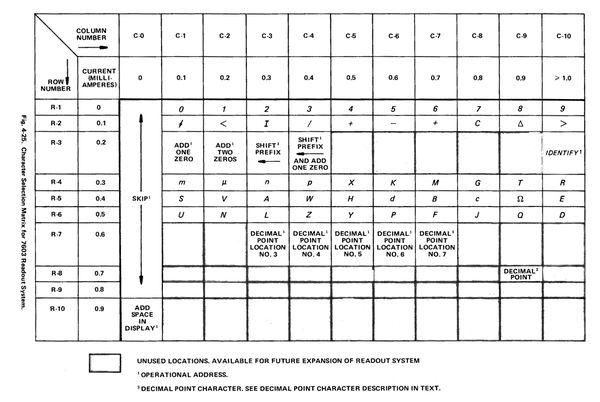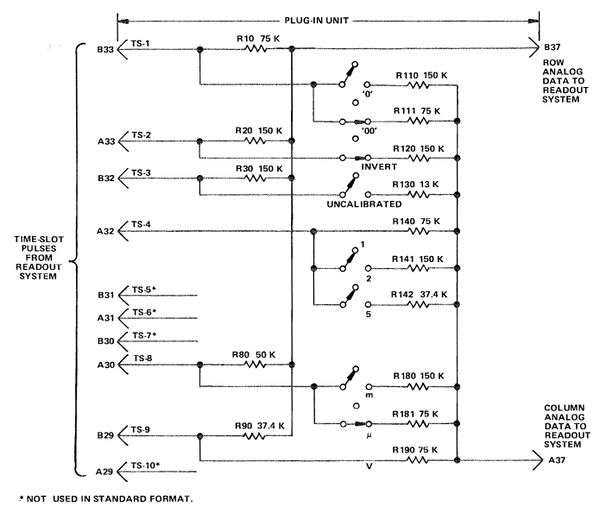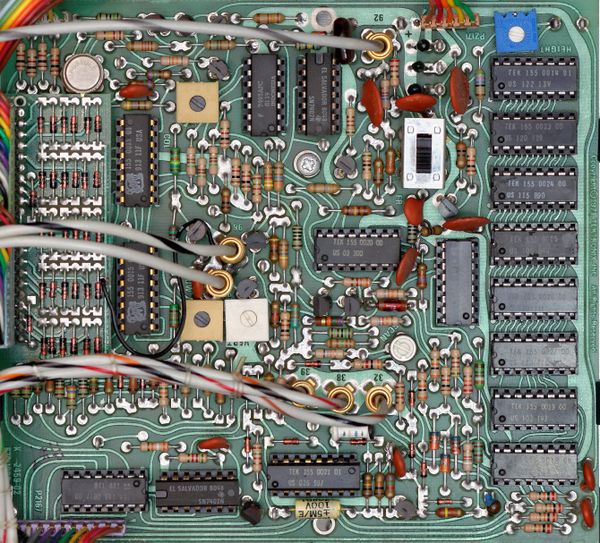7000 series readout system: Difference between revisions
(→Probe interface: typo) |
(character generator details) |
||
| Line 5: | Line 5: | ||
==Layout== | ==Layout== | ||
[[File:Tek7000-readout-positions.jpg|thumb|right|200px|screen layout]] | [[File:Tek7000-readout-positions.jpg|thumb|right|200px|screen layout]] | ||
A total of eight display fields can be superimposed on the CRT picture, four on top and four at the bottom. These are logically associated with the four possible slots in full-size mainframes, with the top field corresponding to the first channel, primary | A total of eight display fields can be superimposed on the CRT picture, four on top and four at the bottom. These are logically associated with the four possible slots in full-size mainframes, with the top field corresponding to the first channel, primary time base or primary function of a plug-in, and the bottom field corresponding to a second channel, delayed timebase, secondary function or unit label. | ||
==Mainframe circuit== | ==Mainframe circuit== | ||
===Scanning=== | |||
The oscilloscope readout system produces a pulse train consisting of 10 successive negative-going pulses representing a possible character in a readout word, and is assigned a time-slot number corresponding to its position in the word. Each time-slot pulse is output at -15 V onto one of ten lines, labeled TS-1 through TS-10 (Time Slots 1 through 10), which are connected to the vertical and horizontal plug-in compartments. | The oscilloscope readout system produces a pulse train consisting of 10 successive negative-going pulses representing a possible character in a readout word, and is assigned a time-slot number corresponding to its position in the word. Each time-slot pulse is output at -15 V onto one of ten lines, labeled TS-1 through TS-10 (Time Slots 1 through 10), which are connected to the vertical and horizontal plug-in compartments. | ||
| Line 14: | Line 15: | ||
[[File:Tek7000-readout-charset.jpg|600px]] | [[File:Tek7000-readout-charset.jpg|600px]] | ||
In time slot 1, special operations can be requested that affect the display in later time slots. These commands are designed to simplify display changes required by external probes that request beam identification or change input sensitivity. The "Identify" command switches to an internal program displaying IDENTIFY instead of any encoded value. Command R3/C1 requests an additional zero to be added starting in time slot 5, R3/C2 adds two such zeroes, R3/C3 shifts the selected prefix one code to the left (i.e. p → n, n → μ, μ → m, m → space), and R3/C4 shifts the prefix and adds a zero. (See the [[Media:Tek-plugin-readout.jpg|encoding circuit of the 7A18 plugin]] for an example implementation.) It is also possible to request a decimal point to be drawn without losing display digits, by encoding row 7 | [[File:7000-readout-chargen-positions.jpg|thumb|300px|right|Character generator matrix positions in 7000 series readout analog character generator ROM]] | ||
In time slot 1, special operations can be requested that affect the display in later time slots. These commands are designed to simplify display changes required by external probes that request beam identification or change input sensitivity. The "Identify" command switches to an internal program displaying IDENTIFY instead of any encoded value. Command R3/C1 requests an additional zero to be added starting in time slot 5, R3/C2 adds two such zeroes, R3/C3 shifts the selected prefix one code to the left (i.e. p → n, n → μ, μ → m, m → space), and R3/C4 shifts the prefix and adds a zero. (See the [[Media:Tek-plugin-readout.jpg|encoding circuit of the 7A18 plugin]] for an example implementation.) It is also possible to request a decimal point to be drawn without losing display digits, by encoding row 7 commands in time slot 1. | |||
The character generators are custom analog chips that provide X and Y output currents for ten characters of up to eight X/Y coordinate pairs inscribing each character. The in-character coordinate points are selected through | ===Character generation=== | ||
The character generators are custom analog chips that provide X and Y output currents for ten characters of up to seven strokes (eight X/Y coordinate pairs) inscribing each character. The in-character coordinate points are selected through a triangular analog signal, not a digital code, which in turn activates one of eight groups of three transistors each generating the X/Y output currents. Each of these groups is fed a constant emitter current (I<sub>E</sub>), and the distribution of this current to the three transistors is controlled by their different emitter areas. The first and second collectors provide X and Y currents respectively, the third ("Z") directs current to the substrate (I<sub>E</sub> - I<sub>X</sub> - I<sub>Y</sub> - I<sub>Z</sub> = 0). Actually, the emitter area itself is not varied in the mask, but out of a fixed number of emitters of equal size, a certain number is connected on each transistor: [[File:7000-readout-chargen-circuit-1.jpg|300px|thumb|ROM circuit for one character (digit "3"). Bases are scanned in turn. The numbers under the emitters indicate how many of the emitters are connected to the common rail. Ten such character circuits plus the scanning (base drive) circuit are integrated in each ROM chip. All X and Y collector outputs are connected across characters and chips.]] | |||
If the bases were controlled by a digital decoder, only one triplet of transistors would be active at any time and only points would be generated on the display. Instead, through an analog driving circuit, gradual cut-over is achieved, i.e. current from one group is reduced while that from the next group is increased, and a linear transition from the first to the second X/Y coordinate pair is displayed as a stroke on the CRT. The actual shape of the base drive voltages has great influence on the proper character rendering (this is explained at length in Gilbert's 1971 SSC paper). | |||
== | ==Plug-in circuit== | ||
A plug-in encodes the desired read-out information either by connecting resistors between the output lines and the time-slot input lines, or by generating equivalent currents. | A plug-in encodes the desired read-out information either by connecting resistors between the output lines and the time-slot input lines, or by generating equivalent currents. | ||
| Line 35: | Line 39: | ||
==Probe interface== | ==Probe interface== | ||
Most 7000 series plugins have rings around the BNC input sockets that allow attached probes to interface with the readout system. The probe connector includes a contact pin connecting this ring. A resistor connected to ground encodes the probe attenuation, e.g. 11 | Most 7000 series plugins have rings around the BNC input sockets that allow attached probes to interface with the readout system. The probe connector includes a contact pin connecting this ring. A resistor connected to ground encodes the probe attenuation, e.g. 11 kΩ indicates a x10 probe. If the probe includes an Identify switch at the tip, this connects the readout pin directly to ground.The [[Media:Tek-plugin-readout.jpg|plug-in circuit]] uses the shift instructions in time slot 1 to implement the change of range. | ||
==Custom chips== | ==Custom chips== | ||
Revision as of 11:18, 30 October 2014
For the 7000-series scopes, a system was required to display the instrument state such as input range, time/div etc. alongside or within the display. Earlier solutions had included fiber-optical/mechanical displays to the side of the CRT such as those in the 576 Curve Tracer.
The design ultimately selected for the 7000 series was proposed and designed by Barrie Gilbert. It uses the CRT beam to display annotations in the same focal plane as the scope's main display.
Layout

A total of eight display fields can be superimposed on the CRT picture, four on top and four at the bottom. These are logically associated with the four possible slots in full-size mainframes, with the top field corresponding to the first channel, primary time base or primary function of a plug-in, and the bottom field corresponding to a second channel, delayed timebase, secondary function or unit label.
Mainframe circuit
Scanning
The oscilloscope readout system produces a pulse train consisting of 10 successive negative-going pulses representing a possible character in a readout word, and is assigned a time-slot number corresponding to its position in the word. Each time-slot pulse is output at -15 V onto one of ten lines, labeled TS-1 through TS-10 (Time Slots 1 through 10), which are connected to the vertical and horizontal plug-in compartments.
Two output lines, row and column, are connected from each channel (two channels per plug-in compartment) back to the oscilloscope readout system. Data is encoded on these output lines as a pair of ten-level analog current sequences (in 100 μA steps from 0 to 1 mA), which can address a matrix of 10 × 10 positions. In this matrix, rows 1, 2, 4, 5 and 6 correspond to characters whereas others are used to encode instructions:


In time slot 1, special operations can be requested that affect the display in later time slots. These commands are designed to simplify display changes required by external probes that request beam identification or change input sensitivity. The "Identify" command switches to an internal program displaying IDENTIFY instead of any encoded value. Command R3/C1 requests an additional zero to be added starting in time slot 5, R3/C2 adds two such zeroes, R3/C3 shifts the selected prefix one code to the left (i.e. p → n, n → μ, μ → m, m → space), and R3/C4 shifts the prefix and adds a zero. (See the encoding circuit of the 7A18 plugin for an example implementation.) It is also possible to request a decimal point to be drawn without losing display digits, by encoding row 7 commands in time slot 1.
Character generation
The character generators are custom analog chips that provide X and Y output currents for ten characters of up to seven strokes (eight X/Y coordinate pairs) inscribing each character. The in-character coordinate points are selected through a triangular analog signal, not a digital code, which in turn activates one of eight groups of three transistors each generating the X/Y output currents. Each of these groups is fed a constant emitter current (IE), and the distribution of this current to the three transistors is controlled by their different emitter areas. The first and second collectors provide X and Y currents respectively, the third ("Z") directs current to the substrate (IE - IX - IY - IZ = 0). Actually, the emitter area itself is not varied in the mask, but out of a fixed number of emitters of equal size, a certain number is connected on each transistor:

If the bases were controlled by a digital decoder, only one triplet of transistors would be active at any time and only points would be generated on the display. Instead, through an analog driving circuit, gradual cut-over is achieved, i.e. current from one group is reduced while that from the next group is increased, and a linear transition from the first to the second X/Y coordinate pair is displayed as a stroke on the CRT. The actual shape of the base drive voltages has great influence on the proper character rendering (this is explained at length in Gilbert's 1971 SSC paper).
Plug-in circuit
A plug-in encodes the desired read-out information either by connecting resistors between the output lines and the time-slot input lines, or by generating equivalent currents.
A simple plug-in such as a vertical amplifier will only require a small number of resistors and possibly diodes in addition to a suitably coded switch.
It will use TS1 to encode the number of zeros, TS2 to display a down-arrow indicating an inverted input, TS3 to display ">" or "<" if the input is uncalibrated, TS4 for a digit, TS8 for a unit prefix like "μ" and TS9 for a unit like "V". The other slots are unused:

Complex plugins
The 7M13 plugin allows the user to encode arbitrary text and numbers plus an optional picture counter value, for photographic documentation.
Digital delay or counter plugins like the 7D11 or 7D14 display up to 8 digit counts in the top field and a unit (e.g. MHz) in the bottom field.
The 067-0905-99 "Readout Exerciser" is a test fixture for the readout system.
Probe interface
Most 7000 series plugins have rings around the BNC input sockets that allow attached probes to interface with the readout system. The probe connector includes a contact pin connecting this ring. A resistor connected to ground encodes the probe attenuation, e.g. 11 kΩ indicates a x10 probe. If the probe includes an Identify switch at the tip, this connects the readout pin directly to ground.The plug-in circuit uses the shift instructions in time slot 1 to implement the change of range.
Custom chips
- 155-0014-01 Analog to Decimal Converter
- 155-0015-01 Analog Data Switch
- 155-0017-00 Zero Logic Counter
- 155-0018-00 Zeros Logic
- 155-0019-00 Decimal Point and Spacing
- 155-0020-00 Output Assembler
- 155-0021-00 Timing Generator
- 155-0023-00 R-1 Character generator (Numerals 0 1 2 3 4 5 6 7 8 9)
- 155-0024-00 R-2 Character generator (Special Symbols ↓ < I / + - + C Δ >)
- 155-0025-00 R-4 Character generator (Prefixes m μ n p X K M G T R)
- 155-0026-00 R-5 Character generator (Letters S V A W H d B c Ω E)
- 155-0027-00 R-6 Character generator (Special Alpha U N L Z Y P F J Q D)
- 155-0038-01 D/A converter
Analog-ROM Readout Board
EPROM-based Readout Board
Towards the end of the 7000 series lifespan, in the 2nd half of the 1980s, a re-designed readout board, Tek part number 670-8622, was used which is based on a 2732 EPROM instead of Gilbert's analog ROMs, e.g. in the 7904A. Some of the Tek-made readout ICs like the timing generator were still used in this version. The number of display points was increased to up to 16 per character. The presence of this board can be detected from the outside by looking at the readout characters - for example, the "V" in the classic board has just two straight lines, whereas they are angled in the digital version.
Literature
- Barrie Gilbert, Monolithic Analog READ-ONLY Memory for Character Generation, IEEE J. of Solid-State Circuits, 1971.
Links
- Repair of readout and installation of readout board in another scope (many photos, German text)
- Thread about probe readout details
Character code table
- A R5/C3
- B R5/C7
- C R2/C8
- D R6/C10
- E R5/C10
- F R6/C7
- G R4/C8
- H R5/C5
- I R2/C3
- J R6/C8
- K R4/C6
- L R6/C3
- M R4/C7
- N R6/C2
- P R6/C6
- Q R6/C9
- R R4/C10
- S R5/C1
- T R4/C9
- U R6/C1
- V R5/C2
- W R5/C4
- X R4/C5
- Y R6/C5
- Z R6/C4
- m R4/C1
- μ R4/C2
- n R4/C3
- p R4/C4
- d R5/C6
- c R5/C8
- 0 R1/C1
- 1 R1/C2
- 2 R1/C3
- 3 R1/C4
- 4 R1/C5
- 5 R1/C6
- 6 R1/C7
- 7 R1/C8
- 8 R1/C9
- 9 R1/C10
- ↓ R2/C1
- < R2/C2
- / R2/C4
- > R2/C10
- Δ R2/C9
- + R2/C5 or R2/C7
- – R2/C6
- Ω R5/C9
